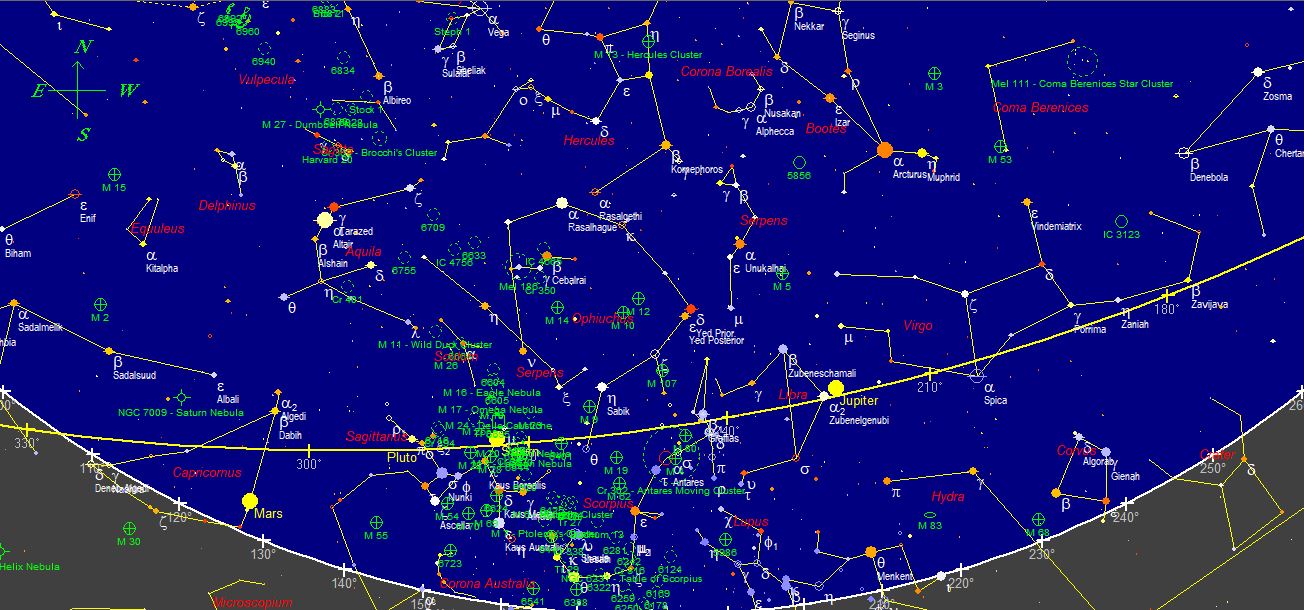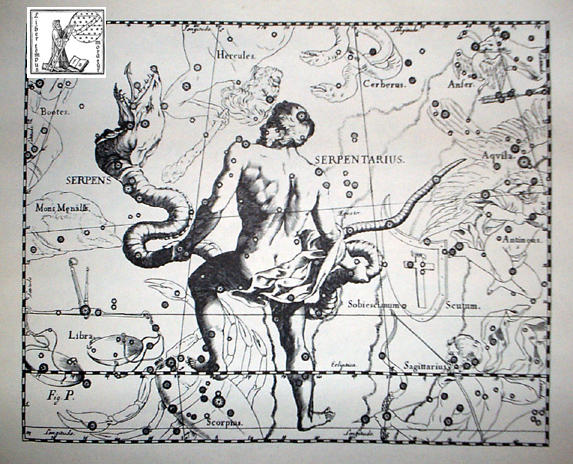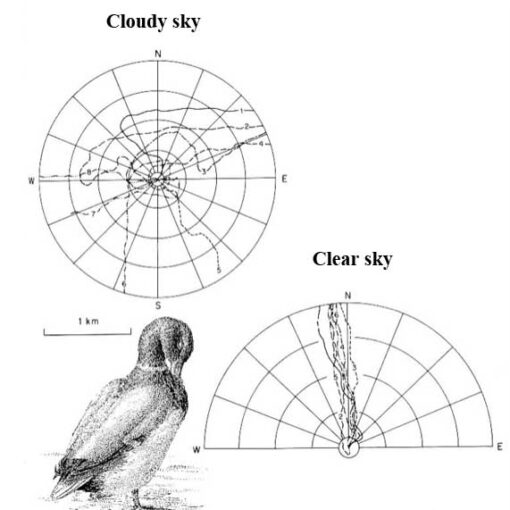
The Sun in Gemini since June 21 passes in Cancer on the 21st of the month,
South facing in the evening, we see after sunset along the course of the night, from West to East, as eclittic constellations, the Lion, the Virgin, the Libra, the Scorpio, Ophiuchus, the Sagittarius, the Capricorn, the Pisces, the Aries and Taurus.
Ophiuchus and the Snake
Ophiuchus is a large constellation placed astride the celestial Equatorial, between Hercules in the north and the Scorpion in the south. The Sun stands there between November 30 and December 18, is the 13th constellation of the Eclectic.
It does not have very bright stars, various stars are double (h, l, x, o, t Ophiuchi); interesting is r Ophiuchi, a multiple star, consisting of two components of magnitude, 5 and 6 accompanied by two stars of magnitude 8 arranged in such a way as to draw a V, visible with small telescopes; it is inserted in a small nebula.

Small telescopes also allow us to see the nearest star to the Soledopol the triple system of a Centauri, the star of Barnard; is 6 a.l.ed is a red dwarf mag. 9.5, located near Cebalrai and close to 66 Ophiuchi. It is the star with the biggest bike of 10.3 seconds of arc per year. It is hypothesized that small terrestrial planets rotate around the Barnard star.Among the other interesting objects of the constellation there are a couple of open clusters, both visible with binoculars like IC 4665, a N of beta, with about twenty old stars 36 million a. and distant over 1000 a.l. and more to E NGC 6633, with about 65 stars at 1600 a.l.; different globular clusters among which M10, of magnitude 6.6, stands out, more to N there is M12 of magnitude 6. to 20.000 to.l..

Snake
The constellation of the Snake has a particularity that distinguishes it from all the others: although it is a single constellation, it is divided into two distinct portions, separated by Ofiuco: to the west is the head of the snake, Serpens Caput, the largest and evident; to the east is the tail, Serpens Cauda.
In the constellation there are some interesting doubles, all separable with small telescopes: b, d, q, n Serpentis. On the border with the Shield is a star cluster, M16, composed of about fifty stars, surrounded by a beautiful cloud of incandescent gas, the Eagle Nebula (Nebulosa Aquila).

Near the border with the Virgin, there is a beautiful globular cluster, M5 of magnitude 6, visible with modest instruments,

Mythology
The constellation of Ophiuchus represents Asclepius, the god of medicine, son of Apollo. Asclepius was educated by the centaur Chiron (represented in the constellation Centaurus) and became so skilled in the medical art that he was able not only to cure diseases, but also to resurrect the dead.
One day Asclepius killed a snake by beating him with his stick and saw another snake arrive, which laid grass on the body of the dead one, making it come back to life immediately. Thus it was that Asclepius knew the secret of resurrecting the dead. In the sky he is depicted holding a snake in his hands (represented by the constellation of the Serpent).
The god of the underworld, Hades, complained to Zeus of the fact that Asclepius subtracted, against nature, the dead souls from his kingdom, then Zeus killed him with a thunderbolt and for reward he gave him a place among the stars.

_______________________________________
The maps of the sky are taken from Skymap, software downloadable in demo version from the site http://www.skymap.com
Credits
Author: Lucia Corbo. As a Natural Sciences teacher and expert in didactics of Astronomy, she has collaborated with various magazines curating articles, columns, and multimedia materials. For the Italian Ministry of Education, she edited the cd “Students show the stars” and with N. Scarpel the book “Astronomy on the net”; she promoted and coordinated the first editions of Astronomy Weeks for schools. She has held multiple refresher courses on the didactics of Science and Astronomy and Astronomy courses for students and adults, both in presence and online.
Translation by Maria Antonietta Sessa




